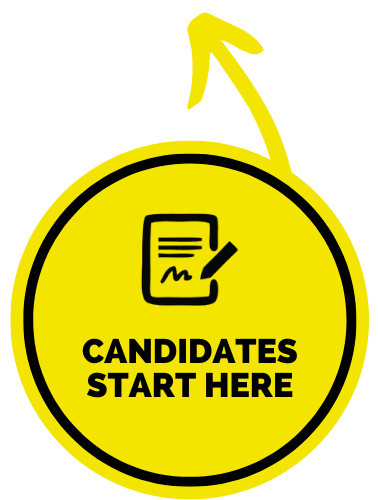
In today’s dynamic and competitive recruitment market, organisations face a myriad of challenges that demand innovative solutions. The complexities of attracting, securing, and retaining top talent are ever-evolving, and staying ahead of the curve is essential for recruitment success. In this landscape, the insights provided in our 2023 Trust Gap Report exceptional significance.
In this article we delve into the core issues plaguing recruitment today, offering data-driven strategies to navigate the hurdles effectively. Understanding these challenges and embracing the recommended solutions is not just advantageous but imperative for organisations and HR professionals striving to optimise their hiring processes, minimise risks, and reduce costs. Join us as we explore the critical challenges and solutions shaping the recruitment landscape of 2023 and beyond.
Candidate Shortage Woes
Attracting the right candidates remains the foremost challenge for 76% of hiring managers, largely attributed to factors like labour shortages and skill gaps.
In this competitive talent market, companies grapple with barriers limiting their candidate pool, such as:
Limited Talent Sourcing:
Many companies confine themselves to a handful of generic job boards, overlooking the potential advantages of diversifying their platforms, leveraging recruitment agencies, and encouraging employee referrals. Expanding sourcing avenues can uncover hidden opportunities and access a wider candidate pool.
Stagnant Job Listings:
Job postings initially enjoy premium visibility on job search platforms but tend to fade into obscurity over time, reducing their visibility to potential candidates. Consequently, fewer candidates discover these listings, leading to a decline in application volume.
Complex Application Processes:
Elaborate and time-consuming online job applications discourage roughly 60% of job seekers from completing them. Simplifying the application process can prevent candidates from dropping out mid-way.
To enhance candidate volume, companies can deploy the following strategies:
Robust Job Marketing:
Develop a comprehensive job marketing strategy that extends beyond generic job boards. This involves tapping into industry-specific, role-specific, local/university job boards, targeted email campaigns, and encouraging employee referrals to attract high-calibre candidates.
Automation and Hiring Software:
Harness the power of hiring software and automation tools like Job Crystal to streamline tasks and enhance efficiency. These tools facilitate sourcing across multiple platforms, offering features such automated messaging to save time and effort.
Removing Application Hurdles:
Elevate the pre-application experience by eliminating barriers like extensive form-filling or pre-screening assessments. Simplifying the application process ensures that candidates are more likely to complete it.
By implementing these strategies, companies can elevate their recruitment efforts, draw in more candidates, and improve their chances of securing top talent.
The Challenge of Candidate Ghosting
A study conducted by Indeed, involving 4,000 job seekers and 900 employers, highlighted a concerning trend: job seekers frequently “ghost” the recruitment process, abruptly disengaging without communication or explanation. The study reveals the extent of this phenomenon:
- 50% of candidates fail to attend scheduled interviews.
- 46% of candidates cease responding to recruiter inquiries.
- 22% of candidates accept job offers but don’t show up on their first day.
- A surprising 75% of recruiters report instances where candidates change their minds after signing an offer letter.
Factors contributing to ghosting include slow employer responses, unclear hiring process information, negative interview experiences, and a tarnished company reputation.
To combat job seeker ghosting, organisations can adopt these strategies:
Streamlined Screening:
Accelerate candidate engagement by efficiently monitoring incoming applications with Applicant Tracking Software (ATS). This allows for organised and seamless candidate communication.
Enhanced Candidate Experience:
Provide regular updates on candidate progress in the recruiting process, offer clear interview and assessment details, and automate communication to ensure consistent and timely interactions.
Multichannel Communication:
Incorporate SMS communication alongside traditional methods like email and job board messaging to boost response rates and overcome technical glitches.
Positive Company Image:
Manage online reputation actively, addressing negative reviews and engaging with feedback while sharing positive testimonials to shape perceptions and build trust.
Open Communication:
Foster open communication with candidates, keeping them informed throughout the recruitment process, setting clear expectations, and providing timely updates to establish trust.
Job seeker ghosting presents a growing challenge in the world of recruitment and hiring. However, by creating a positive candidate experience, employers can reduce ghosting instances, bolster their reputation, attract top talent, and cultivate a robust and engaged workforce.
Hiring Team Burnout:
In recent months, an alarming 98% burnout rate among HR professionals has emerged, with a staggering 78% contemplating leaving their roles. HR professionals attribute this burnout to overwhelming workloads and sub-optimal processes within hiring teams across the industry.
The hiring process encompasses various stages, each laden with its unique challenges:
Attracting Candidates:
To garner a substantial number of applications, hiring teams often manage numerous job listings across different sources, including company career pages, social media, recruitment agencies, and various job boards. This labor-intensive task demands hours of work and requires manual updates without automation.
Screening & Resume Review:
The average of 250 resumes received per job offer makes screening and comparing applicants from diverse sources a challenging task, leading to delays and potential candidate ghosting.
Interviews and Assessments:
Managing a multitude of candidates, scheduling assessments and interviews, and ensuring efficient communication becomes daunting without software and automation. Additionally, incorporating assessments, reference checks, and background screenings adds significant administrative work.
Onboarding and Retention:
Extending a job offer marks just the beginning. HR professionals must ensure effective communication, engagement, and a seamless onboarding process to prevent candidates from disappearing after acceptance.
Organisations can employ these strategies to alleviate stress and address recruitment challenges:
Job Listing Automation:
Streamline the distribution of job listings across various platforms to eliminate manual effort and save valuable time.
Applicant Tracking Software (ATS):
Implement an ATS to track candidates, manage hiring stages, and efficiently review qualifications, simplifying candidate management and reducing errors.
Autoresponders:
Set up automated responses to engage candidates throughout the hiring process, minimising communication lag and drop-off rates.
Centralised Communication:
Simplify candidate tracking and contact by centralising all communication within an ATS. This streamlines candidate communication and ensures efficient and effective correspondence.
CV Grading & Review Tools:
Embrace AI-based CV grading tools and quick review platforms connected to job boards and candidate sources to assess applications swiftly in one centralised place, eliminating the need to compare CVs across separate platforms.
To combat HR burnout and recruitment fatigue, organisations must establish a culture that prioritises hiring as an ongoing, strategic process. Investments in streamlined procedures, automation, and applicant-tracking software are essential, recognising that a business’s growth is intertwined with its team’s growth. Organisations should actively seek top talent and approach hiring as a competitive process.
Approximately 80% of recruitment tasks can be automated, enabling HR professionals to accomplish their responsibilities faster and more efficiently with just a fraction of their current energy expenditure.
The Challenge of Exorbitant Cost per Hire
According to SHRM’s findings, the hiring process incurs substantial costs, with an average cost per hire of $4,600 and executives bearing an even more significant expense of $28,000. These figures underscore the financial commitment required, especially considering the average 42-day duration to fill a position. However, these cost calculations should not overlook additional expenses such as onboarding and training costs. Employers suffer an average loss of $18,700 for every subpar hire, emphasising the importance of making the right choices.
The cost per hire comprises various elements
Internal Costs:
- HR Salaries: Calculating the hiring manager’s hourly salary and multiplying it by the hours spent on each hire.
- Infrastructure Cost: Factoring in space and tools used during the hiring process.
- Employee Referral Bonuses: Incentives provided to employees who refer successful candidates.
- Employee Signing Bonuses & Relocation Costs: Expenses associated with signing bonuses and relocating new hires.
External Costs:
- Agency Fees & Recruiter Commissions: Expenses incurred when engaging external recruitment agencies.
- Advertisement Costs: The budget allocated to job advertisements.
- Career Fairs / On-Campus Events / Conventions, etc.: The cost of participating in recruitment events.
- Assessment Services: Fees for candidate assessments.
- Background Check Services: Costs associated with conducting background checks.
Labor costs typically represent over 70% of the total cost per hire. Optimising processes and leveraging automation tools to enhance HR team efficiency is crucial for cost reduction.
The cost of training and onboarding is often omitted from cost-per-hire calculations but should not be overlooked. Jobvite reports that 33% of new employees quit within the first 90 days, underscoring the significance of effective onboarding.
Companies dedicate approximately 33 hours to training each new hire, costing around $1,800, including training expenses, trainer salaries, new hire salaries, onboarding documentation, administrative labor, and equipment costs.
Glassdoor research indicates that robust onboarding processes improve new hire retention by over 80% and productivity by more than 70%.
To establish an effective onboarding process, consider the following guidelines:
- Detailed Onboarding Plan: Develop a comprehensive plan for the initial week or more, tailored to the new employee’s readiness, with meaningful tasks and responsibilities assigned.
- Extended Onboarding: Maintain a structured onboarding program beyond the initial settling-in phase, spanning the first 90 days and featuring regular training sessions throughout the first year.
- Buddy System: Implement a buddy system by assigning a mentor or “buddy” to new employees. This fosters a sense of belonging and familiarity through activities like lunches and coffee meetings.
Investing in effective onboarding practices and optimising the hiring process enhances talent retention, productivity, and overall employee satisfaction. These measures minimise the cost of bad hires and create a positive employee experience.
The High Cost of Bad Hires
Organisations often feel pressured to fill positions swiftly, leading to HR burnout and rushed hiring decisions. A significant 20% of employees leave within the first 45 days, with 74% of companies reporting an average loss of $18,700 per poor hire. Companies must confront these challenges and optimise their hiring processes to mitigate these costly outcomes.
According to a study by the Brandon Hall Group, 95% of organisations make bad hires annually, resulting in substantial financial losses. To accurately assess the direct cost of a bad hire, organisations should consider various contributing factors. While initial hiring costs may range from hundreds to thousands of dollars, expenses linked to a bad hire can quickly escalate. For instance, Zappos discovered it spent $100 million on bad hires and now offers dissatisfied employees a $3,000 separation bonus within the first few months.
To determine the direct cost of a bad hire, organisations should consider these elements:
- Compensation: The salary associated with the job position.
- Training: Expenses related to new-hire training and ongoing employee development.
- Cost to Hire: Recruitment costs.
- Termination Cost: Administrative and legal costs, along with potential compensation.
Additional variables to consider include equipment and benefits, termination costs, missed business opportunities, team performance, and the loss of customers in roles involving sales and customer service.
Organisations can optimise their hiring process and reduce bad hires by addressing key areas of concern:
Poor Interview Process:
Establish a standardised interview process to minimise ad hoc hiring decisions. This involves outlining key areas to cover at each stage of the interview process.
Weak Employer Brand and Negative Candidate Experience:
Prioritise strengthening the employer brand and creating a positive candidate experience to attract and retain top candidates.
Inadequate Onboarding Process:
Extend onboarding beyond the initial phase, ideally for the first 90 days of employment, to help new hires integrate smoothly into the organisation.
Insufficient Predictive Analytics:
Leverage Predictors of Performance (POP) assessments to identify suitable candidates or make informed decisions when selecting among top contenders.
In conclusion
The recruitment landscape of 2023 presents both opportunities and challenges for organisations seeking to attract and retain top talent. Staying informed about the latest challenges and metrics is vital for proactive recruiters. To achieve recruitment success, organisations should embrace innovative strategies, standardised interview processes, employer brand strengthening, and positive candidate experiences.
Recruiters who adhere to these principles and establish robust recruitment processes will position their organisations for sustainable growth and success in the dynamic business landscape of the future. Vigilance, adaptability, and proactivity will enable recruiters to transform recruitment challenges into opportunities and build a workforce that drives organisational excellence in the years ahead.
About Job Crystal:
Job Crystal is a leading innovator in the field of recruitment AI, dedicated to creating cutting-edge technologies that help make a dent in unemployment. With a strong focus on ethics, transparency, and human collaboration, we strive to develop AI systems that empower individuals and organisations while upholding the highest standards of responsibility.









